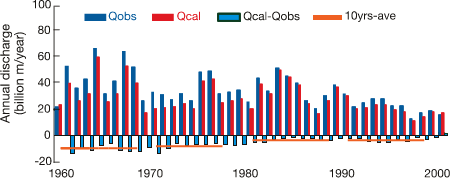Recent Rapid Change of Water Circulation in the Yellow River and Its Effects on Environment
A complex set of interacting factors, including natural climate variation, human-caused global warming and changes in land-use, contributed to the 1997 drought crisis in the Yellow River basin. This project evaluated how land use changes affect the water cycle throughout the Yellow River drainage basin and the effect of decreasing groundwater storage on marine environments. This study may prove to be at the forefront of ecological studies of densely-populated coastal zones. In studying the Bohai and Yellow Seas we may also be able to evaluate the effects of Yellow River change on marine products in the Sea of Japan.
Project Leader: FUKUSHIMA Yoshihiro Tottori University of Environmental Studies (RIHN until March 2008)
Outcome
By implementing our Yellow River Study Project (hereafter referred to as YRiS), we were able to invite young and excellent researchers from Chinese universities and institutes. We were also able to obtain good results from the exchange of information between Japanese and Chinese scientists, and from our analysis based on observations, investigations and inspections in the period of 2003-2007.
We found that reforestation works undertaken by the Institute for Soil and Water Conservation on the Loess Plateau, which occupies almost 40% of the Yellow River Basin, have increased evapo-transpiration and consequently decreased the volume of river water by 15 billion m3. The Chinese Yellow River Conservancy Commission was previously unaware of the link between decreasing river flow and upstream reforestation. Furthermore, regulation governing use of the Yellow River water by surrounding provinces gave each province independent authority. After the severe exsiccation in the Yellow River basin, an improved “water law” was established in 2002. It granted the central government complete authority over river water use and the ability to penalize over-use. Fortunately, there has been a rather large amount of precipitation on the North China Plain since 2000, so there were no instances of the unfair use of river water.
Reforestation has decreased erosion from the Loess Plateau, but the downstream riverbed is still continuing to increase or to maintain the same level despite the completion of the Xiaolandi Dam in 1997 and its important function of flushing out sediment on the riverbed by instigating small flood events. This means that there is increased danger of a flood disaster in an area in which nearly 100 million people live.
The environment of the Bohai Sea has been changed by the shortage of inflow water from the Yellow River. Firstly, the critical condition for primary bio-production has changed from Nitrogen to Phosphorus. Secondly, the exchange of fresh and sea water has decreased remarkably. Thirdly, chlorophyll-a has decreased with the decrease of river water. These findings suggest that primary bio-productivity in the Bohai Sea is decreasing.
How changes in land use affect the atmosphere above the Loess Plateau is still being analyzed. Topographic conditions and the strength of the Asia Monsoon seem to have a larger effect on the atmosphere than do land surface conditions.
It is estimated that almost 10 billion m3 of water is used in upstream irrigation districts such as Qintongxia and Hetao, an amount that has likely remained constant between 1960 and 2000.
Plans for water supply using three routes from the Chang Jiang River to Beijing, Tianjin and the North China Plain may be completed soon. Whether or not water pollution, which is now a serious concern, will be resolved by this project will become a principal issue in the future because of the large cost of addressing such pollution.
Accounts of our study can be found in the YRiS Newsletters 1-8, published from September 1, 2003 to January 31, 2008 (http://www.chikyu.ac.jp/yris/newsletters.html).
Future Issues
In the history of the Japanese Archipelago, there are examples of both long-term sustainability and collapse. The common view that pre-modern or indigenous humans lived in harmony with nature, a harmony disturbed by modern science and technology, is partially true. Human ability to modify nature increased dramatically through time, and the earlier incentives to utilize local bio-resources in a sustainable way were displaced by growing access to global economies and trade. Traditional knowledge does not guarantee sustainable resource utilization, however; traditional systems sometimes have led to over exploitation of resources. Project research found that the level of community governance plays a critical role in sustainable use of ecosystem services: non-local systems of governance frequently led to collapse. Such findings strengthen the case for enhanced support of community or local governance, espcially by the people suffering most from current and future ecosystem service degradation. In some cases, long-term sustainability or recovery from collapse was achieved through collaboration of actors sharing both traditional and scientific knowledge, including, for example, that allowing alignment between local and non-local layers of governance.
 |
| Fig. Result of model simulation for the Loess Plateau area |

